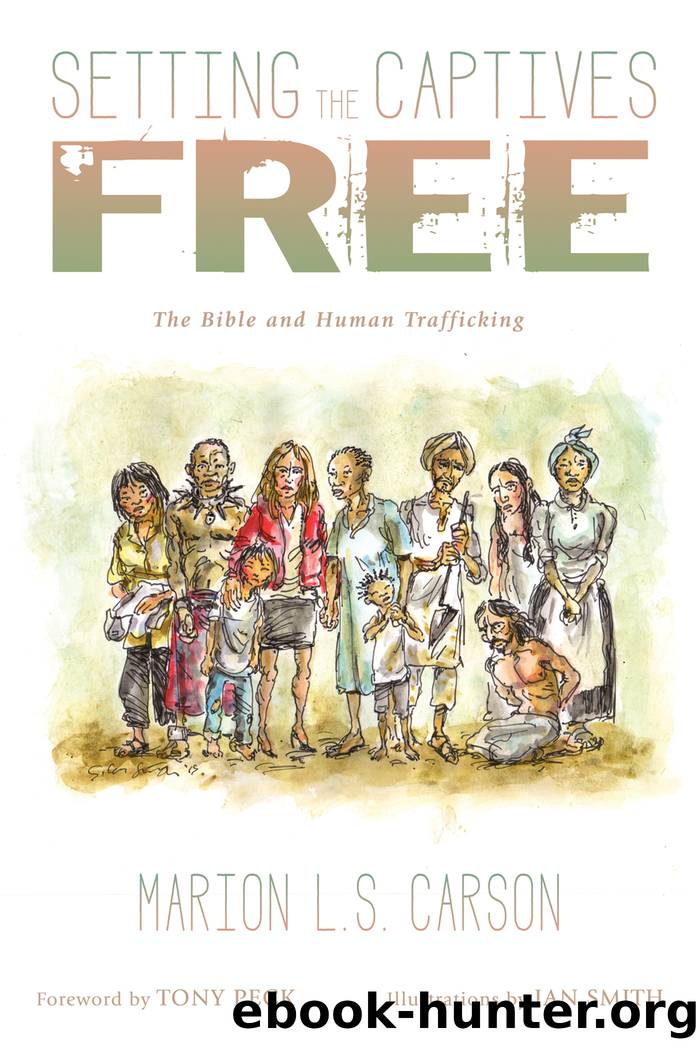Setting the Captives Free by Carson Marion L. S.;Peck Tony;Smith Ian;

Author:Carson, Marion L. S.;Peck, Tony;Smith, Ian; [Carson, Marion L. S.]
Language: eng
Format: epub
ISBN: 9781498233477
Publisher: Wipf and Stock Publishers
Published: 2015-12-07T08:00:00+00:00
12. Patterson, Slavery and Social Death, 13.
13. The letters YHWH are the consonants of the Hebrew designation for God.
14. Bauckham, The Bible in Politics, 26.
5
Slavery in the New Testament
Introduction
The world in which the New Testament writers lived was, in effect, made up of three groups of peopleâthose who were free, those who were slaves, and former slaves who had been granted their freedom. Although slaves were at the bottom of the social pecking order, some could become influential in their own spheres, and even have slaves of their own. They could become physicians, civil servants, or secretaries, and those who developed such skills could be very valuable to their masters. Nevertheless, in a culture in which social honor was all-important, to be a slave was to be in a shameful position. Slaves and their families were the property of their masters. They had no identity of their own, were considered to be inherently inferior, and had no rights in society. Even those who gained their freedom through manumission (the technical term for granting a slave his or her freedom) always retained the shame of having been a slave. The whole of societyâs economic and political structures were built on the implicit belief not only that slaves were necessary, but that it was perfectly natural that some people should be enslaved.
Of course, the worldview of the first-century Graeco-Roman world regarding slavery is entirely foreign to most of us in the Western world today. Though some were disturbed by the cruel treatment of slaves and tried to deal with them humanely, it would never have occurred to them that this world order could be changed. In this chapter, we shall consider how the earliest Christians understood their lives within such a world. What difference did believing in Jesus make with regard to slavery in the first century, and what can we learn from this for today?
Jesus and Slavery
Since slavery played such an essential role in the first-century world, it is hardly surprising that slaves are frequently mentioned in the New Testament. In Matthew 26, the high priestâs slave has his ear cut off, and later in the chapter, a slave-girl identifies Peter as having been with Jesus, which, of course, Peter then denies. In Acts 12:13â15 it is another slave-girl, named Rhoda, who recognizes Peter after he has escaped from prison. There are frequent references to slaves throughout the epistles and we know that there were both slaves and masters in the earliest congregations.
Slaves also appear in the stories Jesus tells. For example, in the Parable of the Weeds and the Wheat (Matt 13:24â30), it is slaves who spot that weeds have been planted in their ownerâs field. They wonder if they should pull up the weeds, but the master tells them not to, explaining that they might pull up the wheat along with them. In the Parable of the Talents, slaves are given the responsibility of looking after very large sums of money for their master (Matt 25:14â30).
Download
This site does not store any files on its server. We only index and link to content provided by other sites. Please contact the content providers to delete copyright contents if any and email us, we'll remove relevant links or contents immediately.
Fangirl by Rainbow Rowell(8807)
How to Bang a Billionaire by Alexis Hall(7941)
Wonder by R. J. Palacio(7749)
The Space Between by Michelle L. Teichman(6588)
The Thirst by Nesbo Jo(6455)
Assassin’s Fate by Robin Hobb(5867)
Wiseguy by Nicholas Pileggi(5334)
The Night Circus by Erin Morgenstern(5043)
The Kite Runner by Khaled Hosseini(4963)
Paper Towns by Green John(4814)
Bittersweet (True North #1) by Sarina Bowen(4719)
Gerald's Game by Stephen King(4386)
Too Much and Not the Mood by Durga Chew-Bose(4105)
Pillow Thoughts by Courtney Peppernell(4035)
Goodbye Paradise(3463)
Twelve Days of Christmas by Debbie Macomber(3421)
Good by S. Walden(3361)
The Rosie Effect by Graeme Simsion(3223)
The Cellar by Natasha Preston(3081)
